Houseplants Care Secrets: Tips for Light, Water & Soil
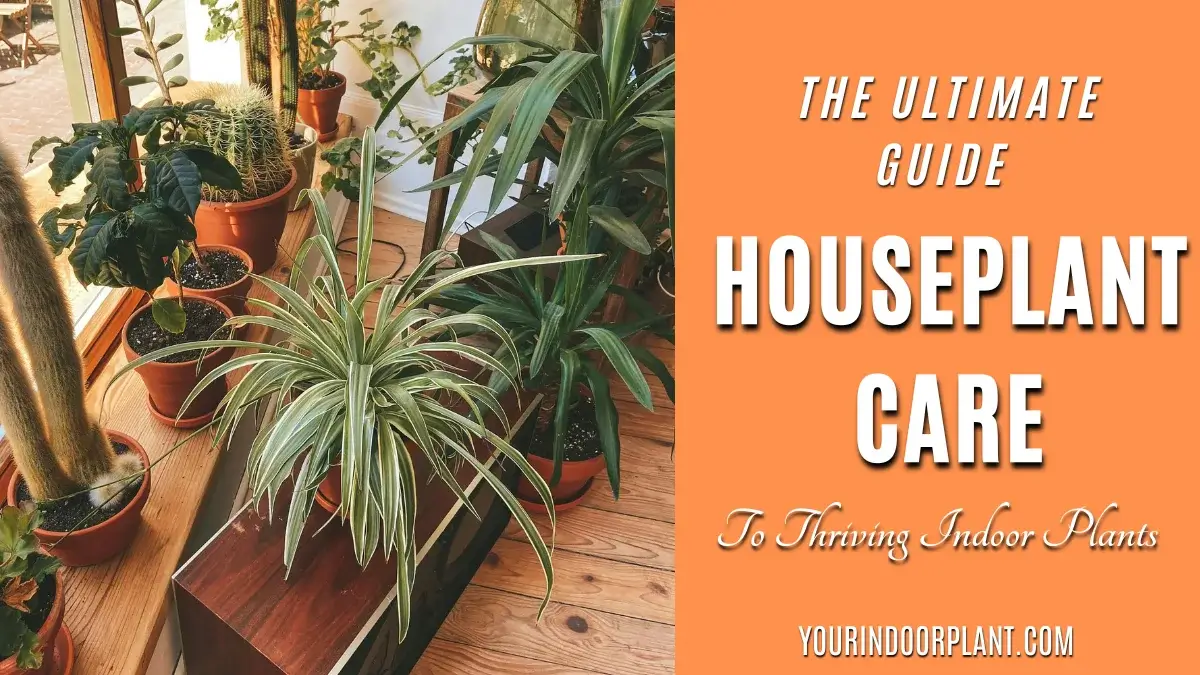
Stop killing your plants. Houseplants care isn’t a secret talent—it’s a skill you can learn. This guide is your first step toward a home filled with thriving, oxygen-rich greenery that boosts your mood and purifies your air.
We’re cutting through the confusion to give you the confidence to master watering, troubleshooting, and all the fundamentals of plant care. Let’s transform your space with happy, healthy indoor plants.
1. Why Bring Nature Indoors? The Benefits of Houseplants
Aesthetic Enhancement
There’s something truly special about how indoor plants can instantly beautify any space. They add natural texture, colour, and life to your home in a way that artificial decor simply can’t match.
Just a single snake plant in the corner can completely transform a sterile room, while a collection of houseplants creates a calming, organic atmosphere that makes any space feel more inviting.
Air Purification
The science behind plants cleaning indoor air is actually quite compelling. NASA research has shown that certain houseplants can remove up to 87% of air toxins within just 24 hours.
Common indoor plants like pothos, peace lilies, and spider plants actively filter pollutants while continuously producing fresh oxygen for your home environment.
Mental Well-being
Multiple studies consistently show that caring for indoor plants offers genuine benefits for mental health. The practice reduces stress, improves mood, and can even increase productivity.
The simple, meditative act of watering your plants or observing new growth provides a wonderful break from daily pressures.
Many offices with plants report significantly reduced stress levels among employees as well.
Creating a Green Space
Beyond the practical benefits, house plants satisfy our innate human connection to nature.
In urban environments where outdoor greenery may be limited, indoor plants fulfill our deep need to nurture living things and maintain that vital link to the natural world right inside our homes.
2. Choosing Your First Houseplant: A Guide for Success
Assessing Your Environment
Before selecting any houseplant, take an honest look at your living space.
- Consider the light conditions throughout your home – identify areas with bright light near windows, medium light zones a few feet from windows, and those low light corners far from natural light sources.
- Check humidity levels too, especially during winter months when indoor air tends to become particularly dry.
- Finally, measure your available space considering both current size and future growth potential.
Beginner-Friendly Plants
When starting your plant journey, it’s wise to begin with forgiving, adaptable species that require only basic care.
- Snake plants are wonderful because they tolerate occasional neglect and handle low light conditions beautifully.
- Pothos grows rapidly in various lighting conditions and helpfully indicates its water needs through visible leaf drooping.
- Peace lilies flower regularly and communicate their needs obviously, while spider plants produce baby plants easily and thrive in most conditions.
For more detailed recommendations on specific easy-care plants, see our full guide to the Best Indoor Plants for Beginners: 14 Easy Care Houseplants.
Pet-Friendly Choices
For pet owners, making plant safety a top priority is essential. It’s vital to verify a plant’s toxicity level with a reliable source before introducing it to your space.
Many popular house plants, including pothos, snake plants, and peace lilies, can be harmful if ingested. Always research specific plant toxicity; for example, you can verify the safety of a common plant like Cupid Peperomia in our detailed guide. Safe alternatives include spider plants, certain orchids, and many succulents.
When in doubt, consult veterinary resources or reliable toxicity guides like the ASPCA’s toxic plant list, and consider hanging plants or elevated placement to keep curious pets safe.
Finding Your Perfect Plant Match
To help determine the best houseplant for your specific conditions, ask yourself these key questions:
- How much natural light does your chosen location receive daily?
- How often do you travel or forget routine tasks?
- Do you prefer plants that require minimal intervention or enjoy regular plant care routines?
Your honest answers will guide you toward plants that truly match your lifestyle and environment.
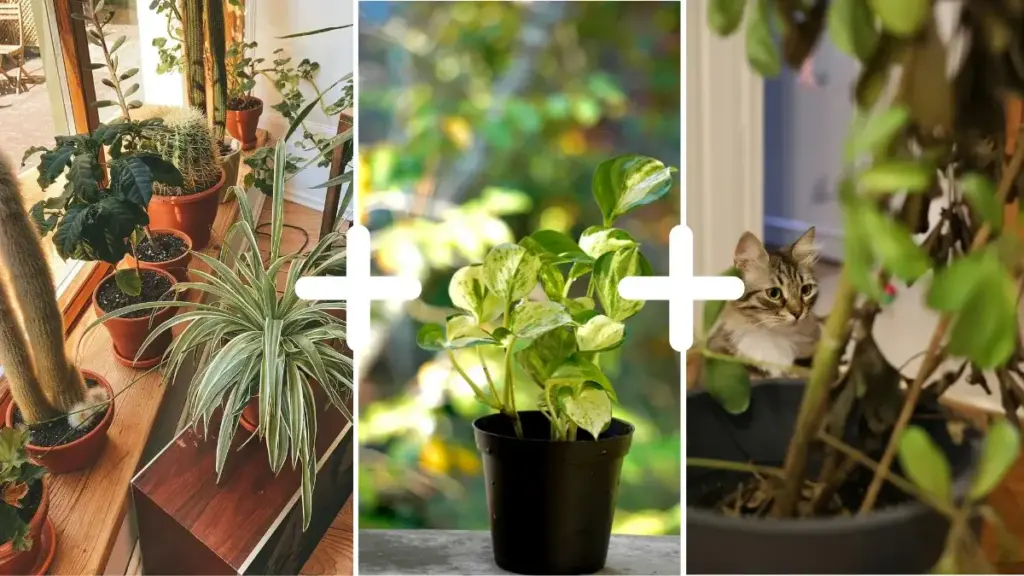
3. The Pillars of Houseplants Care: Essential Principles
Light: The Lifeblood of Your Plants
Understanding light requirements truly forms the foundation of successful indoor plant care. Different plants require varying amounts of light to properly photosynthesize and grow.
Plants categorized as high-light thrive with several hours of direct sun pouring onto their leaves, whereas those that prefer medium light do best in a brightly lit spot where the sun’s rays never directly touch them.
The good thing about many popular houseplants is that they actually prefer low light conditions, making them perfect for interior spaces away from windows.
Learn to recognize the signs when your plant needs more or less light.
- Leggy growth reaching toward windows usually indicates insufficient light exposure.
- Pale or yellowing leaves often signal that plants need light adjustments.
- Brown, scorched leaf tips typically suggest too much direct sunlight.
Rotating your potted plant weekly ensures even growth on all sides. While most plant care can be successfully managed through careful observation alone, if you want to move beyond guesswork, an affordable light meter can be a fantastic tool.
For precise light measurement, consider an inexpensive digital light meter (lux meter). Brands like Dr.meter or Sonkir offer reliable models available online for under $30. These devices provide exact foot-candle or lux readings, allowing you to perfectly match a plant’s listed light requirements to the specific spots in your home.
For a quick check, you can also use free light meter apps on your smartphone, like:
- Lux Light Meter (iOS/Android) is a popular free option that uses your phone’s sensor to give a good baseline reading. For the most accurate smartphone option.
- Photone (iOS/Android) is highly recommended by plant communities for its ability to measure PAR and PPFD (the light metrics plants actually use for photosynthesis).
Using a meter is especially helpful for diagnosing tricky medium-light areas or ensuring your high-light plants are truly getting enough sun, particularly during the darker winter months.
Watering: Finding the Right Balance
Proper watering technique genuinely separates successful plant parents from those who struggle. Most houseplants prefer thorough watering followed by partial drying, rather than frequent small amounts.
Light intensity is the primary driver of your plant’s thirst. A specimen basking in bright rays will deplete soil moisture much faster than its counterpart in a shady corner, demanding a more attentive watering schedule.
Master the finger test and other methods for checking soil moisture. Insert your finger 1-2 inches into the potting mix; if the top feels dry, most plants are ready for water.
Some tropical plants prefer consistently moist soil, while succulent species need complete drying between waterings.
Understanding the difference between overwatering and underwatering isn’t just about spotting symptoms—it’s about understanding what’s happening to your plant beneath the soil.
Overwatering is essentially root suffocation
A plant’s root system depends on the oxygen trapped in the soil’s air pockets for respiration, making well-aerated potting mix absolutely critical to its health.
Soggy, saturated soil smothers them by eliminating this vital air supply, causing the roots to literally drown. Without oxygen, the roots begin to die and decay, becoming mushy and brown. This condition is called root rot.
The dying roots can no longer absorb water or nutrients, which is why the plant above ground shows yellowing leaves and soft, mushy stems—it’s literally starving and dehydrating from the roots up.
Underwatering, on the other hand, is cellular dehydration
Water pressure (turgor) is what keeps plant leaves firm and stems upright. A lack of water causes this internal pressure to plummet, making the plant’s leaves and stems go limp.
To conserve its remaining water, the plant will often shed leaves, and the soil will contract and pull away from the pot’s edges.
If it continues, the plant’s cells will become permanently damaged, leading to crispy, brown leaves and eventual death from an inability to perform basic functions like photosynthesis.
The key is finding that sweet spot where the roots have access to both ample water and plenty of oxygen, allowing your plant to truly thrive.
Essential Watering Reference Guide
| Plant Type | Light Needs | Watering Frequency | Humidity Preference | Ideal Temperature Range | Pet Safety |
|---|---|---|---|---|---|
| Snake Plant (Dracaena trifasciata) | Low to Bright Indirect | Every 3-6 weeks. Let soil dry completely. | Low | 70-90°F (21-32°C) | Toxic to cats and dogs. Causes nausea, vomiting. |
| Pothos (Epipremnum aureum) | Low to Bright Indirect | Every 1-2 weeks. Let top 50% of soil dry. | Moderate | 65-85°F (18-29°C) | Toxic to cats and dogs. Causes oral irritation, vomiting. |
| ZZ Plant (Zamioculcas zamiifolia) | Low to Bright Indirect | Every 3-4 weeks. Let soil dry completely. | Low | 65-75°F (18-24°C) | Toxic to cats and dogs. Causes oral irritation, vomiting. |
| Prayer Plant (Maranta spp.) | Medium to Bright Indirect | Every 1 week. Keep soil consistently moist (not soggy). | High | 65-80°F (18-27°C) | Non-Toxic. Safe for cats and dogs. |
| Hoya Carnosa (Hoya spp.) | Bright Indirect | Every 2-3 weeks. Let soil dry almost completely. | Moderate to High | 60-80°F (15-27°C) | Non-Toxic. Safe for cats and dogs. |
| Peperomia (Peperomia spp.) | Medium to Bright Indirect | Every 1-2 weeks. Let top 50% of soil dry. | Moderate | 65-75°F (18-24°C) | Non-Toxic. Safe for cats and dogs. |
| Philodendron (Philodendron spp.) | Medium to Bright Indirect | Every 1-2 weeks. Let top 50% of soil dry. | Moderate to High | 65-80°F (18-27°C) | Toxic to cats and dogs. Contains calcium oxalate crystals. |
Disclaimer: This table is a general guide. Always observe your plant’s specific needs and environment. For pet safety, the ASPCA website is the most authoritative resource.
Humidity: Creating a Tropical Paradise
Many houseplants originate from tropical environments with naturally high humidity. Indoor air, especially during heating season, often lacks sufficient moisture for optimal plant health. Understanding why humidity matters helps you create better growing conditions for your green friends.
Boosting the moisture in the air for your tropical plants is easy with a few simple tricks.
- Grouping plants together allows them to create their own humid environment through collective transpiration.
- Placing plants on pebble trays filled with water (ensuring pot bottoms don’t sit directly in water) works well too.
- Small room humidifiers provide consistent moisture for larger plant collections.
Expert Tip: Misting can offer temporary relief but it is not a long term solution for increasing humidity.
Soil & Potting: The Foundation for Growth
Quality potting mix provides the essential foundation for healthy plant growth. Never use regular garden soil for indoor plants, as it’s too dense and compacts easily in containers, leading to poor drainage and aeration that can suffocate roots and cause problems like root rot.
Different plant families require specific soil formulations:
- Most tropical plants thrive in well-draining, general-purpose potting mix.
- Succulent and cactus species need specialized, fast-draining mixtures.
- Orchid plants require very chunky, bark-based mediums that allow air circulation around roots.
Choose containers with adequate drainage holes to prevent water from accumulating at the bottom. Proper drainage is absolutely essential for preventing overwatering issues and maintaining healthy root systems.
For advanced plant care, consider specific soil components like perlite for drainage, orchid bark for aeration, and coco coir for moisture retention. These amendments allow you to customize potting mix for individual plant needs.
Every plant family has its own perfect recipe for potting mix. For instance, getting the soil just right is a key part of what makes Peperomia such a joy to grow indoors. You can find the perfect blend and all their care secrets in our dedicated Peperomia Care Guide: How To Grow Peperomia Indoors.
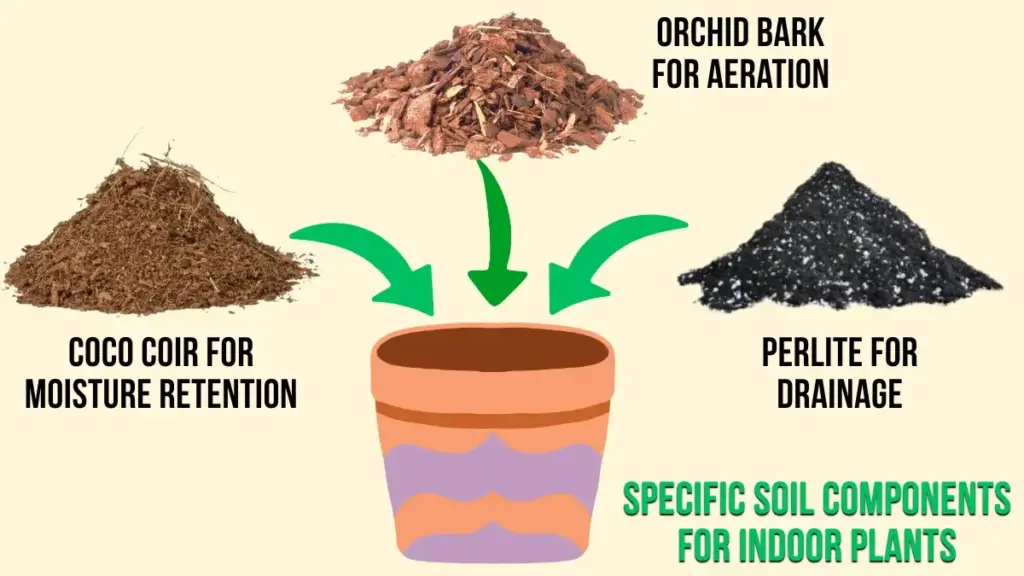
Fertilizing: Feeding Your Green Friends
Plants require nutrients beyond what they can obtain from potting mix alone. During the growing season (spring and summer), most houseplants benefit from regular fertilization every 2-4 weeks using diluted liquid fertilizer. Understanding when and how to fertilize prevents both nutrient deficiencies and over-fertilization problems.
Different types of fertilizer serve various purposes:
- Liquid fertilizers provide immediate nutrition and are easy to control.
- Slow-release pellets offer consistent feeding over several months.
- Organic fertilizers like worm casting tea offer a mild, slow-release nutrient source.
Watch for signs that indicate fertilizer needs. Pale new growth, slow development, or poor flowering often suggests nutrient deficiency. Conversely, excessive fertilizer can cause salt buildup, brown leaf tips, or unusually dark foliage.
As daylight shortens in autumn and winter, your plants’ growth will pause. Follow their lead and pause your fertilization routine until spring’s return. Always follow product instructions and err on the side of less rather than more – it’s easier to add nutrients than to remove excess fertilizer from soil.
Repotting: Giving Room to Grow
Eventually, every houseplant outgrows its current container. Recognizing when to repot prevents plants from becoming root-bound, a condition where roots circle endlessly around the pot interior, limiting growth and water uptake.
Signs that indicate repotting time include:
- Roots growing through drainage holes
- Soil drying out unusually quickly
- Slowed growth despite proper care
Most houseplants benefit from repotting every 1-3 years, depending on growth rate and current pot size.
Learn proper repotting technique to avoid shocking your plant:
- Water thoroughly a day before repotting to make the process easier.
- Gently remove the plant from its current pot
- Examine roots for health
- Place the plant into a new pot that’s just a size up, filled with fresh potting mix. A good rule of thumb is to choose a new container whose diameter is only an inch or two larger than the old one.
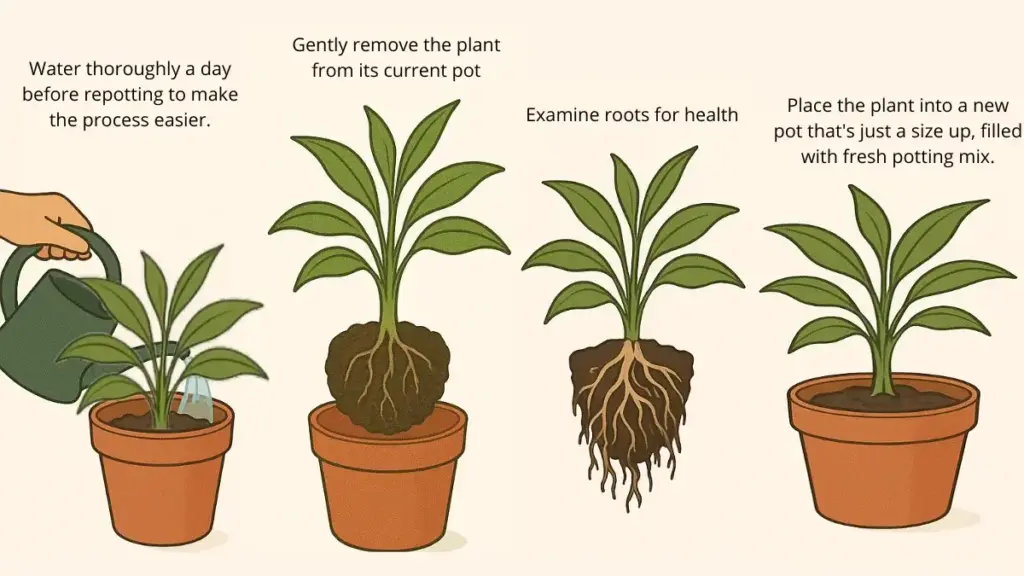
Cleaning & Maintenance: Keeping Them Pristine
Regular maintenance keeps your houseplants looking their best and functioning optimally. Clean plant leaves remove dust that blocks light absorption and can harbour pests. Discover the best methods for different plant types in our step-by-step article, How to Clean Houseplants.
Pruning serves both aesthetic and health purposes. Remove dead, yellowing, or damaged leaves promptly. This not only discourages pests from moving in but also allows the plant to focus its resources on pushing out new, vigorous growth. Some plants benefit from occasional pinching to encourage bushier growth patterns.
Regular inspection during routine care helps catch pest problems early when they’re easier to address. Look for unusual spots, webbing, sticky residue, or tiny moving insects that might indicate unwanted visitors.
4. Troubleshooting Common Houseplant Problems
It’s helpful to frame plant troubleshooting as proactive problem-solving rather than reactive crisis management.
Regular observation during routine plant care helps identify issues before they become serious problems.
Since most houseplant issues stem from environmental factors—light, water, or humidity imbalances—rather than diseases or pests, a great place to start is with a general overview of these common mistakes. For a comprehensive list, see our guide on 15+ Houseplant Mistakes Killing Your Plants (Quick Fixes).
Pests: Unwanted Guests
Common houseplant pests include:
- Spider mites (tiny, often creating fine webbing)
- Mealybugs (white, cotton-like clusters), aphids (small, soft-bodied insects)
- Fungus gnats (tiny flying insects around soil)
Early identification makes treatment much more effective.
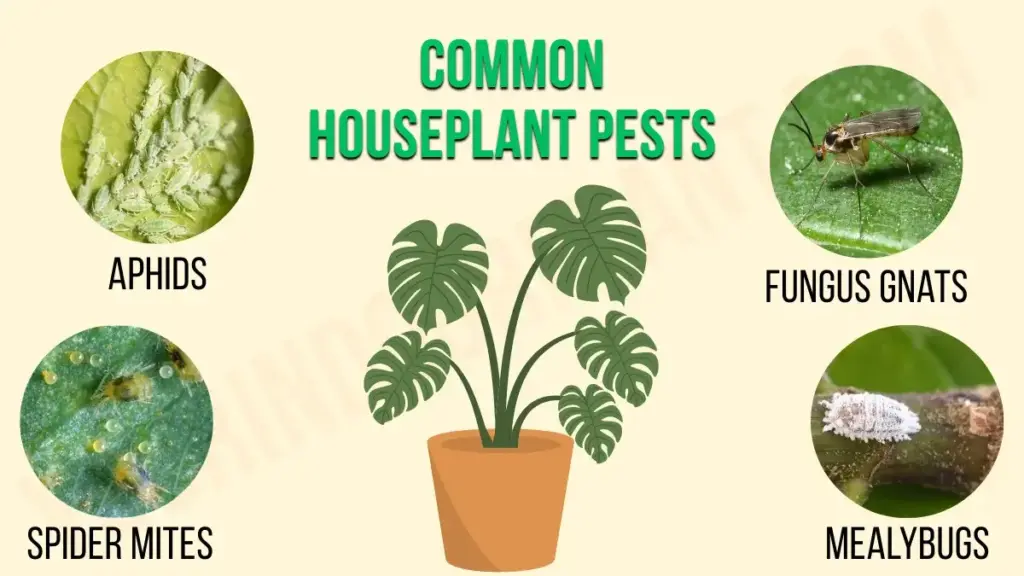
Both organic and chemical treatment options exist for pest control. Insecticidal soap works well for soft-bodied insects. Neem oil provides broad-spectrum control for many common pests. If a pest problem has gotten out of hand, you might need to use a systemic treatment that the plant absorbs to address the issue from the inside out.
Expert Tip: Introduce beneficial insects as an eco- friendly pest control method for indoor plants.
Diseases: When Plants Get Sick
The most frequent disease issues for indoor gardeners are often fungal, such as powdery mildew or unsightly brown spots on foliage. These problems often result from poor air circulation, excessive humidity on leaf surfaces, or overwatering conditions that create favourable environments for fungal growth.
Prevention strategies include:
- Ensuring adequate air circulation around plants.
- Avoiding overhead watering that leaves moisture on leaves.
- Maintaining appropriate watering schedules.
When problems occur, remove affected plant material immediately. For a specific example of treating a common fungal issue, see our guide on How to Treat Leaf Spot on Philodendron: Easy Solutions.
Good air circulation and proper watering practices prevent most fungal diseases, making environmental management the best approach.
Root Rot: The Silent Killer
Root rot develops when plant roots sit in waterlogged soil for extended periods, creating oxygen-poor conditions where harmful bacteria and fungi thrive. This condition kills more houseplants than any other single problem.
Causes include overwatering, poor drainage in containers without adequate drainage holes, or using potting mix that retains too much moisture. Early signs include yellowing leaves, soft stems, and a musty odor from soil.
Treatment requires immediate action. For comprehensive, step-by-step instructions, see our guide on 7 Tips for Treating Root Rot in Houseplants (Easy Fixes). This will walk you through removing the plant, examining the roots, cutting away any black or mushy sections with sterile tools, and repotting in fresh mix.
Prevention remains the best strategy:
- Use containers with proper drainage
- Water appropriately for plant needs
- Ensure adequate air circulation around root zones.
Leaf Discoloration & Issues: What Your Plant is Telling You
Plant leaves communicate health status through color changes and physical symptoms.
- Yellow leaves often indicate overwatering, underwatering, or natural aging, depending on the pattern and location.
- Crispy, brown leaf tips are usually a cry for help, signaling dry air, irregular watering habits, or a buildup of fertilizer in the soil.
- Drooping leaves usually signal thirst and root issues, though some plants naturally droop when they need water.
For a clear example of how to diagnose and fix common leaf issues, see our guide to Common Fishbone Prayer Plant Problems (and How to Fix Them Fast).
5. Beyond the Basics: Advanced Houseplant Care
Propagation: Growing Your Collection
Plant propagation allows you to expand your collection economically while sharing plants with friends. Different methods work for various plant types.
- Stem cuttings work well for pothos, philodendrons, and many tropical plants. Most stem cuttings root easily in water before transplanting to soil.
- Leaf cuttings succeed with succulent species. They require patience as new plants develop slowly.
- Division works for plants that naturally form multiple crowns or offsets. It should be done during active growing seasons for best results.
Visual guides showing various propagation techniques can be extremely helpful for beginners learning these skills.
Pruning & Shaping: Aesthetics and Health
Strategic pruning maintains plant size, encourages bushier growth, and removes unhealthy material. Different plants require different approaches – some benefit from regular pinching, while others need occasional major pruning sessions.
Timing matters for pruning activities. Most houseplants respond best to pruning during active growing seasons when they can quickly recover and produce new growth. Always disinfect your pruning shears or scissors to avoid disease transmission between plants.
Learn which plants tolerate heavy pruning and which require gentle approaches. Some species bounce back quickly from aggressive pruning, while others may be permanently damaged by excessive cutting.
Specific Plant Care Spotlights
While general principles apply broadly, some plants have unique requirements worth highlighting. Hoyas thrive in plenty of indirect sunlight and like their soil to become entirely dry before you give them another drink. Their thick, waxy leaves store moisture efficiently. For a complete breakdown of their needs, see our Hoya Plant Care: Complete Wax Plant Care Guide & Tips.
- Hoya carnosa varieties are particularly popular for their fragrant flower clusters and relatively easy care requirements. With the right conditions, these resilient plants can become lifelong companions, often thriving for many years. For more easy tips on this variety, read our Hoya Carnosa Care: Easy Wax Plant Tips for Growing Indoors.
- Prayer plants (Maranta) need their soil kept evenly damp and crave a more humid environment than most common houseplants. Their leaves fold up at night, giving them their common name. For key care points, these 7 Stunning Tips You Need are essential.
- Ctenanthe varieties, related to prayer plants, have similar care requirements but often feature more dramatic leaf patterns and colors. To learn about the unique needs of a specific type like the Burle-Marxii, our guide on how to care for a ctenanthe burle-marxii is a great resource.
6. FAQs
-
How do I know if I’m overwatering or underwatering my plant?
Overwatering often leads to yellowing leaves, soft, mushy stems, and eventually root rot. Underwatering causes dry, crispy leaves, wilting, and stunted growth. The best way to tell is to check the soil moisture; if the top 1-2 inches are dry, it’s likely time to water.
-
What’s the best way to increase humidity for my tropical plants?
Grouping plants together, placing them on a pebble tray filled with water (ensuring the pot doesn’t sit in the water), or using a small room humidifier are effective methods. Misting provides only very short-term humidity.
-
My plant has sticky residue on its leaves. What is it?
Sticky residue, often called “honeydew,” is typically a byproduct of sap-sucking pests like aphids, mealybugs, or scale insects. Inspect your plant closely for these pests and treat accordingly.
-
How often should I fertilize my houseplants?
Most houseplants benefit from fertilization during their active growing season (spring and summer), typically every 2-4 weeks with a diluted liquid fertilizer. Reduce or stop fertilizing during fall and winter when growth slows. Always follow the specific product instructions.
-
Can I use regular garden soil for my indoor plants?
No, it’s not recommended. Garden soil is too dense and can compact easily in pots, leading to poor drainage and aeration, which suffocates roots and causes problems like root rot. Always use a high-quality potting mix specifically formulated for indoor plants.
7 .Conclusion
You now have the essential plant care tips: from choosing the right plant for your light and lifestyle to mastering watering, soil, and troubleshooting.
Imagine the satisfaction of a home filled with thriving plants that improve your air and your mood. That reality is within your reach.
Take the next step in your plant journey. Start with one easy plant, or explore our specific care guides to dive deeper.
Remember, every expert was once a beginner. Embrace the learning process, celebrate each new leaf, and enjoy the peaceful joy of growing your own indoor sanctuary.
